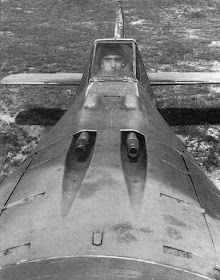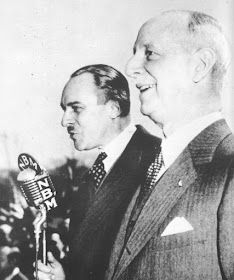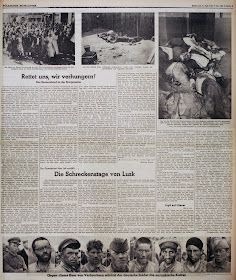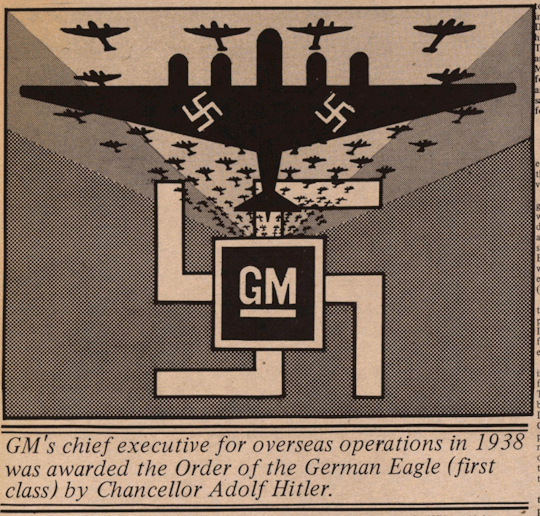 |
| American-made? |
While any association with the Third Reich became toxic from a public relations perspective after 1941, prior to that it was acceptable - so long as it was profitable. Unlike today, when any association with an openly Fascistic regime would generate immediate protests, in those days there were not many who kept track of corporate political involvement. So, there were plenty of United States companies doing business behind enemy lines.
I want to stress that this article is not meant as an indictment of any particular person or corporation. However, the more we learn about the past, the more we learn from the past.
That said, there remains little publicity about United States corporations that profited from the Third Reich. They also helped the German war effort in other ways. Below are just a few controversial examples of US companies that helped Hitler. It is but a sampling of a myriad of corporate interests in Occupied Europe.
ITT
International Telephones and Telegraph, now ITT Corporation, was founded in 1920. It was a young and vibrant company during Hitler's rise to power. By the mid-1930s, it had extensive holdings in South America and Europe. It essentially created Telefónica, the premiere telephone utility of the Spanish-speaking world. It also acquired various telecommunications companies in Belgium, England, Germany, Romania and elsewhere in Europe. Its business interests on the Continent ranged far and wide. This all became quite embarrassing for the company in later years, as we will get to below.
 |
| Maurice Deloraine, a top French ITT engineer, and Sosthenes Behn in 1946. |
Speaking of Telefónica, unproven rumor has it that its phone lines were used for communications to German naval interests in South America. However, ITT's businesses went way beyond telecommunications, however. From his first year as Chancellor of Germany, in August 1933, Adolf Hitler was working his US contacts for help to the growing German empire. The support reportedly came in different guises: direct cash payments to SS-Reichsfuhrer Heinrich Himmler from the 1930s right up to 1944, and also direct investment in German industry. The legendary ITT boss Sosthenes Behn reportedly was a huge fan of the Fuhrer, though it should be stated that this was before the horrors of the concentration camps became widely known.
 |
| A Focke Wulf Fw 190 fuselage assembly plant at Kolleda, Germany, 1945. |
So, ITT ultimately had $30 million invested in Germany at the time of Pearl Harbor. One of ITT's investments in Germany was 25% of Focke-Wulf. That was a rather modest aircraft manufacturer before the war, but it blossomed into the creator of the deadly Focke-Wulf 190 fighter, which some feel was the best fighter of the entire conflict (and one of the most-produced). It is difficult to fathom now, but in 1943, 13% of ITT's income derived from Germany.
 |
| When Kurt Tank's Fw-190 first appeared in August 1941, it was considered superior to any existing Allied fighter. It remained a lethal opponent and ground attack plane to the end of the war. |
The weirdness does not stop there. ITT's plants were busy churning out the means of Germany's defense, so of course the Allies bombed those plants. In the 1960s, ITT had the audacity to sue the US government for a share of reparations funds allocated to damaged caused by the war - to compensate for the German Focke-Wulf plants destroyed in the Allied air raids. Probably more amazing is that ITT is said to have won the case and pocketed millions of dollars in compensation (the amount given in the sources varies but is generally held to have been $27 million in 1960s money). The reasoning by the court may have been that ITT was itself a victim of the Germans by having lost control of the plants during the war, but it remains a very tortured legal decision.
Associated Press
The Associated Press, or the AP as it is more commonly known, was founded in 1846 in New York City as a consortium of newspapers. It developed over time into a dominant news agency, and of course remains so to this day. |
| The Völkischer Beobachter (translates roughly to "Racist Observer"), a Party house newspaper, used photographs by AP photographer Franz Roth. |
By the 1930s, the AP was pretty much in the position it inhabits now: a global disseminator of news and information. The Germans, of course, were all about disseminating news stories, so long, of course, as they had a hand in writing or otherwise shaping them. It was a partnership made in ... somewhere. This is where it gets a bit tricky for the AP.
 |
| The 11 December 1941 German declaration of war ended the AP's relationship with the regime. |
The Germans swiftly banned foreign news agencies that did not "play ball" after they came to power. By 1935, most bureaus in Germany had been shut down pursuant to the Germans' "editors law," which prevented any news flow not calculated to further the Hitler war effort. The AP, however, was not banned. In fact, it continued its German operations straight through to Hitler's declaration of war against the United States on 11 December 1941. This has remained somewhat of an irritant for esteemed publications, such as, say, The Guardian (shut down in Germany in 1934), that remain in business alongside the AP.
 |
| Sure, photographs from within the Third Reich were informative and scarce in the Allied countries. They also were carefully crafted to create an image of German strength. |
While this may sound innocuous - so they forwarded news stories, so what? - many historians don't see it that way. As can be seen elsewhere on this site, the German Ministry of Propaganda under Joseph Goebbels was artful at creating manufactured photographs and "stories." Passing along such propaganda greatly extended the reach of the German news agency. This included publicizing photographs taken by SS photographers such as Franz Roth - a top AP photographer as well.
 |
| SS Kriegsberichter Franz Roth was killed in March of 1943 in the Kharkov sector. Kriegsberichter is a German word for Combat Photographer. Roth allegedly contributed his photos to AP. |
Naturally, there are two sides to this story. The AP adamantly denies helping Hitler in any way. It admits disseminating Third Reich photographs, but only with clear communication of the tainted source for recipients. Historian Harriet Scharnberg went through all this recently, and if you understand German you might find this abstract of her book interesting reading on the subject. The bottom line is that the AP did indeed profit from Hitler, Goebbels and the SS.
Postscript: Subsequent to my writing this article, on 10 May 2017 the AP released its own report on its World War II conduct. You can read the AP report itself here. The report speaks for itself and you are free to read it. It is characterized by other media sources as a "denial."
What follows is my interpretation of that report.
The AP report by Larry Heinzerling, an adjunct assistant professor at the Columbia Graduate School of Journalism and retired AP deputy international editor, with contributions by AP investigative researcher Randy Herschaft, is a rebuttal to Harriet Scharnberg's claims. The report, as you might expect, denies that the AP was in any way complicit with the Third Reich. The report states:
We recognize that AP should have done some things differently during this period, for example protesting when AP photos were exploited by the Nazis for propaganda within Germany and refusing to employ German photographers with active political affiliations and loyalties. However, suggestions that AP at any point sought to help the Nazis or their heinous cause are simply wrong.The report admits that its contributor Roth was a committed member of the NSDAP and travelled with the SS - which, of course, was committing unspeakable atrocities in the Soviet Union at the time. However, the report claims that, except for one known exception, photos published by AP were not altered by the Germans - though, as any photographer will tell you, any picture tells a story that is framed by and reflects what the photographer wants you to see.
The report sets forth AP's position on doing business with the Third Reich:
Although the exchange necessitated dealing with the Nazi regime, it was the AP’s belief then and now that the photos gave the U.S. public a much fuller picture of the war than could have been obtained otherwise. That included scenes of fighting on the Russian front, the results of bombings of German cities and Germany’s falling war fortunes.So... basically, the AP admits to doing business with the Third Reich. However, according to this report, they performed their own balancing act, concluding that getting the photos was worth it.
 |
| "Der Untermensch" was a SS Pamphlet that used AP photos (AP). |
It is worth pointing out that other media organizations refused to do what AP did. They did not feel that photos taken by SS men were so valuable that they needed to be published. As to Germany's "falling war fortunes"... they weren't falling that much prior to 11 December 1941.
That leads to another aspect of AP involvement with the Third Reich. It also is worth pointing out that AP continued printing photos from the Third Reich even after the US entered the war in December 1941. The AP secured at least some of them via the Lisbon photo agent F. Marquis de Costa in neutral Portugal. For instance, the AP published photos from the Battle of Stalingrad, which did not even begin until August 1942. So, the AP continued its ties with the Third Reich through circuitous means. The extent to which the Third Reich may have benefited from that continued association with the AP is open to interpretation - as indicated above, the German Propaganda Ministry used AP photos in government publications, though it could have done that regardless of any AP ties.
I hope I set forth the AP's position accurately. If not, my apologies. The report, as I said above, speaks for itself, as does the Scharnberg exposé.
Ford
The Ford Motor Company has had international interests since shortly after its founding by Henry Ford early in the 20th Century. Those interests always set it apart somewhat from General Motors, which also had international operations, but never on the scale of Ford. However, let's not get sidetracked; let's look just at Ford and its influence on the Third Reich.
Henry Ford became something of a folk hero long before World War II. If any one person created the modern middle class, it was Henry Ford. He did a lot of good in his life. However, his international involvements and personal beliefs led him into some very unsavory situations.
 |
| The Dearborn Independent was the Ford house organ and regularly featured stories about Henry Ford's favorite topics. |
Henry Ford was a well-known anti-Semite. While that would automatically disqualify him from any position of leadership today, before World War II it was somewhat fashionable in certain quarters. Ford was one of Hitler's earliest backers; the New York Times reported in its 20 December 1922 edition - before almost anyone had heard of Adolf Hitler, and before even the 1923 Beer Hall Putsch - that Ford was financing Hitler in Munich, Germany. In fact, this became a matter of deep concern to the Weimar Republic government, and it indirectly asked the US Ambassador to Germany to put a stop to Ford's involvement with opposition parties. Ford, though, continued his support.
Hitler greatly admired Henry Ford, and is said to have had a portrait of the American tycoon in his Munich offices and copies of Ford's books displayed on tables. It was Ford money that financed the Beer Hall Putsch. After that failed, Hitler wrote "Mein Kampf," which directly quoted from some of Ford's own books.
 |
| Ford trucks were on every European Front. |
Ford remained very much on the Germans' minds. Hermann Goering always traveled on his command train with several Ford automobiles, which he preferred to more ponderous German cars. Hitler gave Ford the Grand Cross of the German Eagle in 1938 for Ford's 75th birthday in August 1938.
 |
| Ford trucks in service with the Afrikakorps |
At this point, you are probably saying to yourself, "Well, so much for Henry Ford being a Hitler friend, but that doesn't mean that Ford itself helped the Germans." Well, the thing is, Ford the company did help the German war effort. It had a German subsidiary Ford-Werke A.G. It technically became a wholly German company shortly before the war, but it obtained its raw materials such as rubber from the American Ford company. Ford also had plants in Amsterdam, Antwerp, Paris, Budapest, Bucharest, and Copenhagen - all cities ultimately taken over by the Germans. Oh, and let's not forget numerous operations in North Africa, which the Germans also held for a few years.
 |
| Ford France trucks used by the Wehrmacht |
So, how did Ford actually help the Germans? Its plants produced some 20 trucks per day in France alone. It also produced spare parts for German vehicles. Ford was raking in profits from these operations throughout the war, and the Allies knew all about it. The USAAF and RAF would bomb Ford plants and take pictures of the devastation for the press, but then carefully tip-toe around actually pointing out that it was a Ford plant that had been bombed.
 |
| A US Ford assembly line for Jeeps. |
Naturally, these sorts of things don't make it into the company's annual reports. However, reviewing the evidence from that time does not show much unhappiness by Ford executives at building vehicles for Hitler. It is important to point out, though, that Ford did not play favorites: it also created Molotov trucks for the Soviet Union, and of course was a huge producer of trucks and planes and related parts for the United States military. Ford's Willow Run plant that produced B-24 bombers is legendary. But facts are facts: those bombers were produced in Ford plants to bomb other Ford plants churning out equipment in Europe for the Wehrmacht.
Other US Companies
Without going into details as above, many other US companies had ties with the Third Reich. Put more precisely, they have been accused of having associations with the Third Reich that earned them substantial sums of money. These corporations included:
- General Motors (GM)
- Chase Bank
- International Business Machines (IBM)
- Random House
- Coca-Cola
 |
| General Motors had a lot to offer the Third Reich. |
General Motors had a long, intricate history with the Third Reich. GM's Chief Executive for Overseas Operations met with Hitler on 2 May 1934 to seek the right to produce the "People's Car" that Hitler personally was designing (which became the Volkswagen Bug). Mooney did not get that contract, but received the Order of the German Eagle (First Class) at the hand of Adolf Hitler in 1938. GM also owned and operated Opel, which supplied 40% of the motor vehicles in Germany and 65% of its auto exports. The latter figure is critical, because it earned Germany the foreign currency it needed to fund military activities. In early 1941, before the US entered the war, GM was reluctant to cut US auto production as requested by the US government in order to shift facilities to war work. This raised questions about its "loyalty."
 |
| Soldiers modelling their stylish uniforms. |
Some sources point out that Hugo Boss should be included in this list, and that founder Hugo Boss himself was a Party member. That claim would be true... if Hugo Boss AG were a US company. In fact, it was founded in 1924 by Hugo Boss in Metzingen, Germany, a small town south of Stuttgart. Hugo Boss was a German, not a US, company. Otherwise, it certainly did do business with Hitler.
Could US Companies Have Acted Otherwise?
It is easy to look back in hindsight and take a moralistic viewpoint. However, the German market could be quite lucrative, and businesses are created to make money. Not too many corporate executives could resist the temptation of doing business with Germany regardless of rumors and even hard news about its domestic practices. As noted above, British media companies forced to curtail business on the Continent greatly resented the continued business there by US companies. It was, though, perfectly legal.
One company that did take a stand, half-hearted and tenuous as it may have been, was film studio Metro-Goldwyn-Mayer.
On 14 June 1940, while the US remained at peace with Germany, MGM released its films "The Mortal Storm." Directed by Frank Borzage based on the book by British writer Phyllis Bottome, and produced by Frank Borzage and Victor Saville, "The Mortal Storm" starred Margaret Sullavan, James Stewart, Robert Young, Frank Morgan and Robert Stack. The film was set in contemporary Germany and depicted some of the sadism and cruelty inflicted by the Hitler regime, although it carefully avoided pointing fingers at anyone in particular. While long forgotten by most movie fans, "The Mortal Storm" was an extremely controversial and widely discussed film in its day.
"The Mortal Storm" was a good film, though not as good as you might think from the many glowing reviews that it receives now. The difference is because reviewers then and now tend to review the politics of the film rather than its actual artistic merit. "The Mortal Storm" was a very rare instance in which a US corporation did something almost certain to antagonize the then-current rulers of Germany. The Germans banned MGM from the German film market due to "The Mortal Storm."
While not the most stunning profile in courage in history, it did require some fortitude for MGM management to greenlight the film and then distribute it despite the obvious potential financial consequences. It also provides a prime example of a US corporation which did, in fact, put some kind of principle ahead of making money.
Conclusion
What does all this mean? Put simply, it means that many highly respected US corporations that remain so today were active profiteers from the devastation of World War II and aided the rise of Hitler's Germany. How things get built and who builds them matters. In some cases, you might have a company building planes that bombed ships which were using that same company's equipment.
This article is not meant to have a political slant or agenda. The truth is all we are after. Wars can be fought for good and noble purposes, but it also pays to follow the money to see who is making a profit from all the bloodshed.
2016



Ford also had a major role in the Soviet's truck industry. In the late 1920s and early 1930s, American Engineers from both Ford and Hercules Motor Companies helped design and build the largest of the USSR's automobile and truck factories, particularly the plants at Gorkiy ("Gorkiy Auto Zavod", or GAZ) and the expanded AMO plant in Moscow, which became ZIS. These two factories produced the Ford AA light truck, which became the GAZ-AA, and the American Autocar 10-ct Lorry, which became the ZIS-5, with later redesigns becoming the GAZ-AAA and ZIS-6.
ReplyDeleteSoviet tractor/tracking towing vehicles were also American licensed variants of the American Holt designs.
It was these factories that were quickly converted to tank production at the start of the war, and why the Red Army experienced such shortages in trucks and transports until the lend lease trucks arrived in 1943.
I know people ignore the fact now, but Russia was our ally during WW2, so it's not as surprising as doing business with an enemy.
ReplyDeleteThanks for taking the time to discuss this, I feel strongly about it and love learning more on this topic. If possible, as you gain expertise, would you mind updating your blog with more information? It is extremely helpful for me. Mason Soiza
ReplyDelete